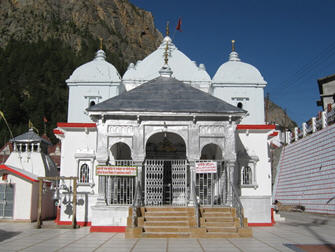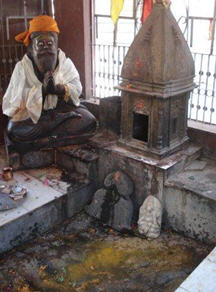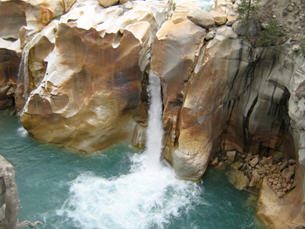The actual source of the Ganges is Gaumukha which is a hard 19km climb from Gangotri. Bhagiratha is said to have performed penanace here at Gangotri to save his relatives. The Pandavas are also said to have visited this place to atone for the sin of killing their relatives during the Kurukshetra war. At this point the Ganges River flows north, giving this village its name, Gangotri, which means “Ganga turned north.” Lord Krishna says in Bhagavad-gita, “Of flowing rivers I am the Ganges.”

Gangotri is a pleasant town and is fairly popular. It is a nice place to stay for a while. The Bhagirathi River rushes by and is extremely loud, giving the place a peaceful atmosphere.
Gangotri is located about 250km from Rishikesh and 230km from Yamunotri. The bus trip via Tehri and Uttarkashi from Rishikesh takes 10 to 12 hours. At Gangotri the Kedar Ganga River merges with the Bhagirathi River at Dev Ghat, which is next to the main bridge, on the other side of the river from the temple.

Gangotri Temple:
The Gangotri Temple is dedicated to the goddess Ganga. It was built in the 18th century by Amar Singh Thapa, a Gorkha general and was later renovated by the Maharaja of Jaipur. It is erected near a sacred stone, called Bhagiratha Shila, which is about 20m (65 ft) to the left of the temple. King Bhagiratha is said to have sat here to worship Siva, so that Lord Siva would take the Ganges on his head. Soon after arati to the deities in the temple, an arati is performed to the holy Ganges River. The temple is open from May to early November.

There is a Water fall called Sahasradhara about 100m below this confluence. Just before the falls the river squeezes itself into a narrow gorge about one meter wide under which is said to be a natural Shiva Lingam. Below the Sahasradhara Falls, only 100 meters from the bus stand, is Surya Kund. Lord Shiva was supposed to have been sitting at this Sahasradhara Falls when the Ganges came down from heaven. That is why this is considered the beginning of the river, according to tradition.
Gauri Kund is only 300 meters further downstream from the bus stand, where the Ganga can be seen flowing through narrow channels.
After Gauri Kund, one can find Patangna, which is two kilometers downstream from the bus stand, where it is believed the Pandavas performed their yagnas and austerities to redeem themselves from killing their relatives in their participation in the Kurukshetra war. After this, along the path is a large cave with a small entrance , called the Pandava Gupha or cave of the Pandavas.
When to Go
The temple here opens with a formal puja to Gangaji on Aksaya-tritya, during the last week of April or first week of May. It closes on Diwali, in the midst of an array of oil lamps. During the winter months, Gangotri is covered with snow. When the temple is closed, there is a grand ceremony in which the priests decorate a palanquin and take the deity of the Goddess Ganga while singing the Ganga Laheri and bring her to Mookhimath in a huge procession. Then the temple doors are closed for 6 months. The worship of Ganga Devi is continued in the temple at Mookhimath until the temple at Gangotri is ready to be opened again.
Travel
Buses from Hanuman Chatti near Yamunotri (13 hr drive) go directly to Gangotri, via Uttarkashi. There is an early morning bus from Hanuman Chatti at 5.30 am, that must be reserved the night before. After that there are a few buses that depart from Hanuman Chatti when full. There is a bus scheduled to leave at 7 am, which arrives the same day. Later buses usually stop for the night at Uttarkashi, which has plenty of places to stay.
From Haridwar or Rishikesh it takes 14 hours to get to Gangotri. From Gangotri to Kedarnath there are regular buses that take a day and a half. No matter how early you leave, you cannot travel the 334km in one day.